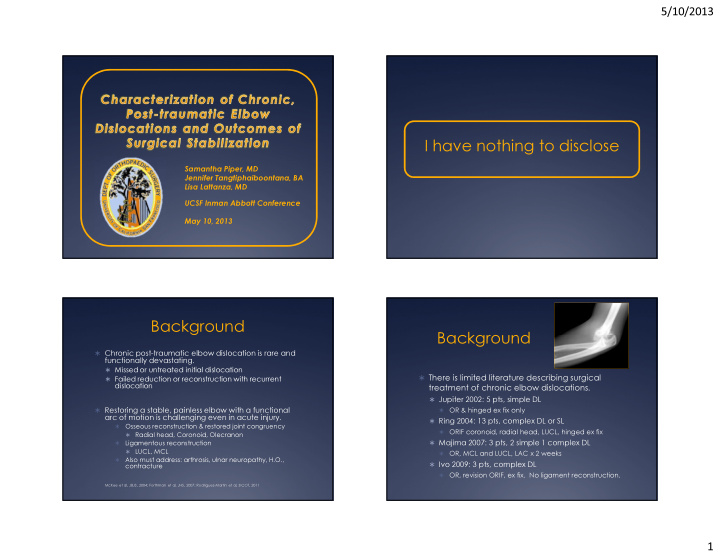



5/10/2013 I have nothing to disclose Samantha Piper, MD Jennifer Tangtiphaiboontana, BA Lisa Lattanza, MD UCSF Inman Abbott Conference May 10, 2013 Background Background � Chronic post-traumatic elbow dislocation is rare and functionally devastating. � Missed or untreated initial dislocation � There is limited literature describing surgical � Failed reduction or reconstruction with recurrent dislocation treatment of chronic elbow dislocations. � Jupiter 2002: 5 pts, simple DL � Restoring a stable, painless elbow with a functional � OR & hinged ex fix only arc of motion is challenging even in acute injury. � Ring 2004: 13 pts, complex DL or SL Osseous reconstruction & restored joint congruency � � ORIF coronoid, radial head, LUCL, hinged ex fix � Radial head, Coronoid, Olecranon � Majima 2007: 3 pts, 2 simple 1 complex DL � Ligamentous reconstruction � LUCL, MCL � OR, MCL and LUCL, LAC x 2 weeks Also must address: arthrosis, ulnar neuropathy, H.O., � � Ivo 2009: 3 pts, complex DL contracture � OR, revision ORIF, ex fix. No ligament reconstruction. McKee et al, JBJS, 2004; Forthman et al, JHS, 2007; Rodriguez-Martin et al, SICOT, 2011 1
5/10/2013 Methods Study Aims � Retrospective review of all elbow stabilization procedures after dislocation to identify chronic elbow dislocations. � Single surgeon at a single institution � Identify patterns of injury that might lead to chronic elbow dislocation � January 2003 - September 2012 � Chronic dislocation >4 weeks (c/w literature) � Exclusion criteria: < 4wks DL, immediate conversion � Evaluate outcomes of surgical treatment of to TEA chronic elbow dislocations � IRB approved study Methods Surgical and Rehab Protocol � A standard surgical protocol was used to restore a concentrically reduced elbow through a full ROM. � Incision based on pathology/previous incisions � 9 patients fit criteria of chronic complete elbow � Open reduction dislocation. � Radial head ORIF/arthroplasty � Mean duration of dislocation 39.7 weeks (4-230.1) � Coronoid fixation or reconstruction � LUCL reconstruction � 4 women & 5 men � MCL reconstruction � Mean age 37.4 years (24-47) � If remains unstable � 5 injured dominant side � Hinged external fixation � Protect ligament reconstruction � 3 MCA, 2 MVA, 1 fall from standing, 1 fall from horse, 1 fall from bike, 1 assault � Post-op rehab consisted of: � 1 cranial injury with ICU stay � 3-5 days post-op: PNI (while inpatient) � 1 day-4 weeks post-op: Elbow CPM � 4 weeks post-op: PT for progressive ROM/strengthening � Mean UCSF follow up 20.8 months (1.8-30.1) � 6 weeks post-op: Static progressive elbow splint 2
5/10/2013 Methods Methods � 4 radial head arthroplasty, 1 revision arthroplasty, 1 radial neck shortening, 1 excision � 2 Simple, 7 Complex � At OSH: 1 ORIF, 1 prior excision, 3 no prior tx � 2 Open � 2 coronoid fixation (1 ORIF buttress plate, 1 patellar allograft buttress plate) � 7 Coronoid fx � At OSH: 2 treated- 1 healed, 1 failed 2 Type I, 2 Type II, 3 Type III (Morrey) � � 4 Anteromedial (O’Driscoll II) � 9 LUCL reconstruction At OSH: 2 LUCL reconstruction- failed � � 5 Terrible Triad � 5 MCL reconstruction (2 in TT, 2 in anteromedial coronoid fx) � 3 Monteggia � At OSH: 1 MCL reconstruction- failed � 2 Essex-Lopresti � 8 ex fix, avg. duration 6.2 weeks At OSH: 2 ex fix at OSH (4 wks), 1 transhumeral pin (3wks) � � 5 had one or more stabilization procedures prior to presentation to UCSF � 3 interposition arthroplasty Results Results � At final follow up: All pts had a significant improvement in ROM � � Complications: Mean pre-op flexion/extension arc 44.1°, mean post-op 119.9° � � 1 conversion to TEA (failed coronoid allograft (p=0.0013) during aggressive PT) � Mean pre-op pronation/supination arc 92.5°, mean post-op 143.8° (p=0.038) � Type III coronoid 7 maintained concentrically reduced, stable joints � � 1 re-dislocated secondary to patient seizure � 8 were pain free with all activities � Type III coronoid not re-constructible � 1 revised LUCL at 3 weeks post op � 2 superficial infections treated with antibiotics only � 3 heterotopic ossification � 2 required resection � 3 ulnar neuropraxias � All resolved by final follow up without treatment 3
5/10/2013 Conclusions � In this small case series, chronic elbow dislocations with a Type III coronoid fracture that could not be reconstructed failed stabilization. THANK YOU! � 56% required MCL reconstruction to maintain stability. � A stable and painless elbow with a functional arc of motion can be restored after a chronic elbow dislocation. � Patients should be counseled regarding the high rate of complications with chronic elbow stabilization. Results 4
5/10/2013 Neglegted medial elbow- MCL and medial bony injuries? Can still make elbow functionaly after 4 years dl Pre-op BIf no coronoid left to fix, stability will be difficult even with soft tissue reconst. May need to allograft coronoid, but this has poor results. Subcategory of elbow dl/fx/dl that do not remain stable after reduction and treatment with standard protocol or standard protocol is not followed � 9 pts, sought to identify characteristics of this subcategory � Anertomedial, not just the anterior coronoid fx that can lead to instability if not fixed. � Simple soft tissue injury if fully stripped Gram King ppr � Post-op � 8 complex, 1 simple (but type $ so no soft tissue attachments) 5
Recommend
More recommend